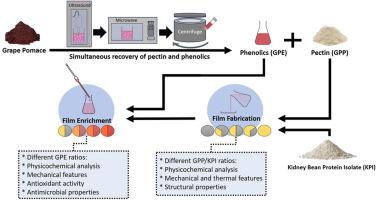Valorization of red grape pomace for sustainable food packaging: Development of pectin/kidney bean protein based biocomposite films enriched with grape pomace polyphenols
IF 11
1区 农林科学
Q1 CHEMISTRY, APPLIED
引用次数: 0
Abstract
Red grape pomace (GP), as an underutilized waste of wine and juice production units, was utilized as a valuable source of pectin (GPP) and extract (GPE). The co-extraction of GPP and GPE was performed using ultrasound-microwave assisted technique and the process factors were co-optimized using response surface methodology, which yielded 20.25% GPP and 21.51% GPE. The compositional characterization of the ingredients indicated a low-methoxyl galacturonic acid-rich structure for GPP and a wide range of phenolic compounds for GPE. The obtained GPP was then employed in the fabrication of a novel biocomposite film with red kidney bean protein isolate (KPI) and the prepared films were evaluated using physicochemical, hydration, barrier, mechanical, thermal and structural analysis. The results revealed that a 50/50 ratio of GPP/KPI improved hydration, barrier and mechanical properties, with water solubility of 14.96%, water vapor permeability of 1.86 × 10−10 g/m.s.Pa, tensile strength (TS) of 36.20 MPa and elongation at break (EB) of 17.90%. The results from FTIR spectroscopy, X-ray diffraction and scanning electron microscope images suggested high compatibility between KPI and GPP and improved structural properties for the composite films. Furthermore, the thermogravimetric analysis presented improved thermal properties for GPP/KPI (50/50) films. Additionally, biodegradability monitoring of GPP/KPI films showed that they begin to deteriorate within eight days when exposed to vegetal compost. Finally, the incorporation of GPE in GPP/KPI (50/50) films in different ratios enhanced TS (up to 45.41 MPa), antioxidant and antibacterial properties, while negatively impacting EB and barrier properties.

红葡萄渣在可持续食品包装中的应用:开发富含葡萄渣多酚的果胶/肾豆蛋白基生物复合膜
红葡萄渣(GP)是葡萄酒和果汁生产单位未充分利用的废物,被用作果胶(GPP)和提取物(GPE)的宝贵来源。使用超声波-微波辅助技术对 GPP 和 GPE 进行了联合萃取,并使用响应面方法对工艺因素进行了联合优化,从而获得了 20.25% 的 GPP 和 21.51% 的 GPE。成分的组成特征表明,GPP 具有富含低甲氧基半乳糖醛酸的结构,而 GPE 则含有多种酚类化合物。然后,将获得的 GPP 与红芸豆蛋白分离物 (KPI) 一起用于制造新型生物复合膜,并通过理化、水合、阻隔、机械、热和结构分析对制备的薄膜进行了评估。结果表明,GPP/KPI 的比例为 50/50,可改善水合、阻隔和机械性能,水溶性为 14.96%,水蒸气渗透性为 1.86 × 10-10 g/m.s.Pa,拉伸强度(TS)为 36.20 MPa,断裂伸长率(EB)为 17.90%。傅立叶变换红外光谱、X 射线衍射和扫描电子显微镜图像的结果表明,KPI 和 GPP 之间具有很高的相容性,复合薄膜的结构特性也得到了改善。此外,热重分析表明,GPP/KPI(50/50)薄膜的热性能有所改善。此外,对 GPP/KPI 薄膜进行的生物降解性监测表明,当它们暴露在植物堆肥中时,会在八天内开始降解。最后,在不同比例的 GPP/KPI (50/50) 薄膜中加入 GPE 增强了 TS(高达 45.41 兆帕)、抗氧化和抗菌性能,但对 EB 和阻隔性能产生了负面影响。
本文章由计算机程序翻译,如有差异,请以英文原文为准。
求助全文
约1分钟内获得全文
求助全文
来源期刊

Food Hydrocolloids
工程技术-食品科技
CiteScore
19.90
自引率
14.00%
发文量
871
审稿时长
37 days
期刊介绍:
Food Hydrocolloids publishes original and innovative research focused on the characterization, functional properties, and applications of hydrocolloid materials used in food products. These hydrocolloids, defined as polysaccharides and proteins of commercial importance, are added to control aspects such as texture, stability, rheology, and sensory properties. The research's primary emphasis should be on the hydrocolloids themselves, with thorough descriptions of their source, nature, and physicochemical characteristics. Manuscripts are expected to clearly outline specific aims and objectives, include a fundamental discussion of research findings at the molecular level, and address the significance of the results. Studies on hydrocolloids in complex formulations should concentrate on their overall properties and mechanisms of action, while simple formulation development studies may not be considered for publication.
The main areas of interest are:
-Chemical and physicochemical characterisation
Thermal properties including glass transitions and conformational changes-
Rheological properties including viscosity, viscoelastic properties and gelation behaviour-
The influence on organoleptic properties-
Interfacial properties including stabilisation of dispersions, emulsions and foams-
Film forming properties with application to edible films and active packaging-
Encapsulation and controlled release of active compounds-
The influence on health including their role as dietary fibre-
Manipulation of hydrocolloid structure and functionality through chemical, biochemical and physical processes-
New hydrocolloids and hydrocolloid sources of commercial potential.
The Journal also publishes Review articles that provide an overview of the latest developments in topics of specific interest to researchers in this field of activity.
 求助内容:
求助内容: 应助结果提醒方式:
应助结果提醒方式:


